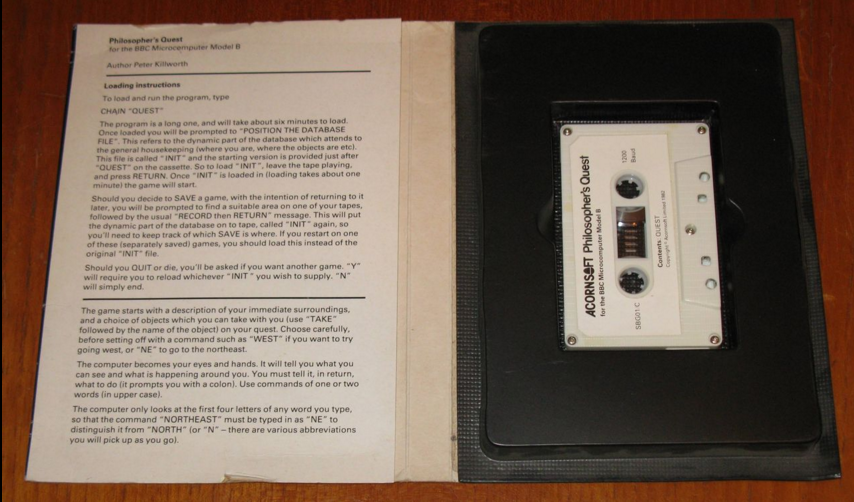I’m going to make a clarification that might be a little too much inside baseball, but Jimmy Maher brought something up I felt deserved a more detailed response. I’ll get back to the main gameplay (and what might the cruelest maze ever) next time.
There are three versions of this game.
A mainframe version from 1979, titled Brand X.
A commercial version for BBC Micro computer published by Acornsoft in 1982, titled Philosopher’s Quest.
A commercial version for various computers published by Topologika in 1987, also titled Philosopher’s Quest.
I’m playing the mainframe version, ported to be playable on modern computers by Graham Nelson, Adam Atkinson, and David Kinder.
The 1982 version was shortened from the mainframe version. If that was the only version titled Philosopher’s Quest, I probably would consider the title assigned to a different game and say I was playing Brand X.

Via BeebMaster. No doubt tape capacity played some role in truncating the original game.
However, the 1987 version restored the original material (with some tweaks). I hence consider the title Philsopher’s Quest to be the “author’s choice” for the game and am calling it that, although I confess I had some angst over the decision (which indicates, possibly, I’m getting into this a little too much) but I have the side justification that most people searching for this game would know it by the latter title.
Here’s the 1979 version, reproduced from my last post:
You are standing in a small shop which normally has various goods displayed for sale. There are areas of the shop obviously intended for the display of treasure. There is an exit south, above which hangs a large sign, which reads:
There is an aqualung with a full tank of oxygen here. It
turns on automatically upon contact with water.
There is a fluffy lace-edged cushion here.
There is a bunch of keys here.
A piece of sausage is curled up here.
There is a small teabag on the floor here.
Here’s how the 1982 version starts:
You are standing in a small shop which normally has goods for sale. There are areas of the shop intended for the display of treasure. There is an exit south, above which hangs a sign, reading: “Leave treasure here. Please note that only two objects may be removed from this shop. So choose carefully!”
There is an aqualung here
There is a bunch of keys here
There is a cup of tea here
There is a steel rod here
Finally, the 1987 version:
You are standing in a small shop which normally has various goods displayed for sale. Areas of the shop are obviously intended for the display of treasure. Above an exit south hangs a large sign, which reads:
Adventurers please note only two implements may be removed from this shop under penalty of death.
So choose carefully!A piece of sausage is curled up here.
There is a fluffy lace-edged cushion here.
A small teabag is lying close at hand.
There is a aqualung with a full tank of oxygen here. It turns on automatically upon contact with water.
There is a bunch of keys here.
Note that the references to Zork and Adventure are stripped away from the sign in both the commercial versions (kind of like how early Zork made a Wumpus reference but dropped it later, likely due to obscure injokiness).
Also not only does the 1982 version have some item differences, it mentions explicitly to drop treasures in the shop while the other two versions don’t. This makes me suspect treasures go somewhere else in those versions.
The difference in objects might be a sufficient hint to figure out which three are needed (remember, you can “cheat” and get one extra past the sign’s rule). Since the aqualung, keys, and tea are the only shared objects, I suspect those are the right ones (and indeed I think I know where all three are used).




















